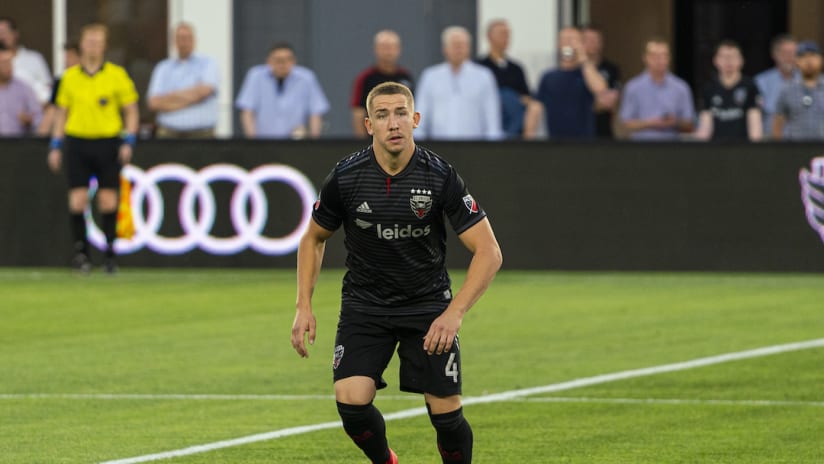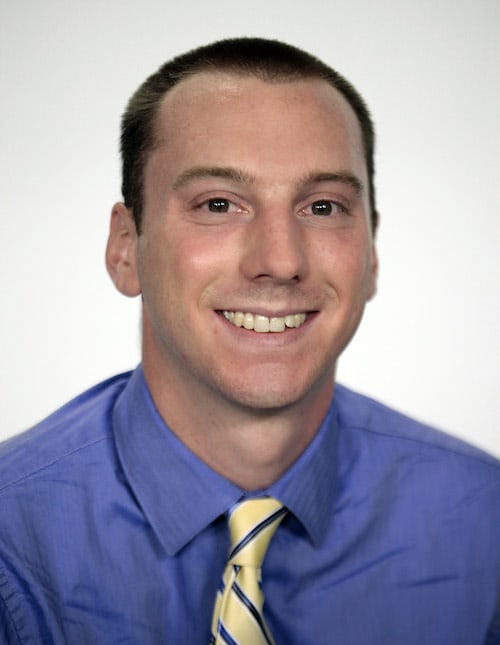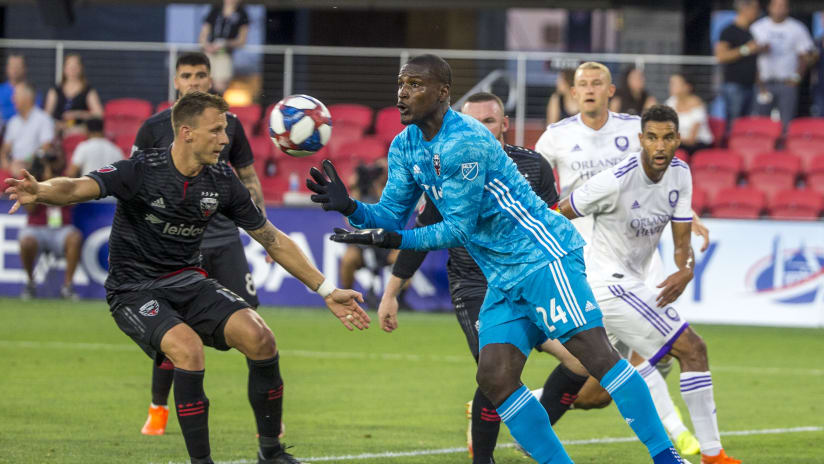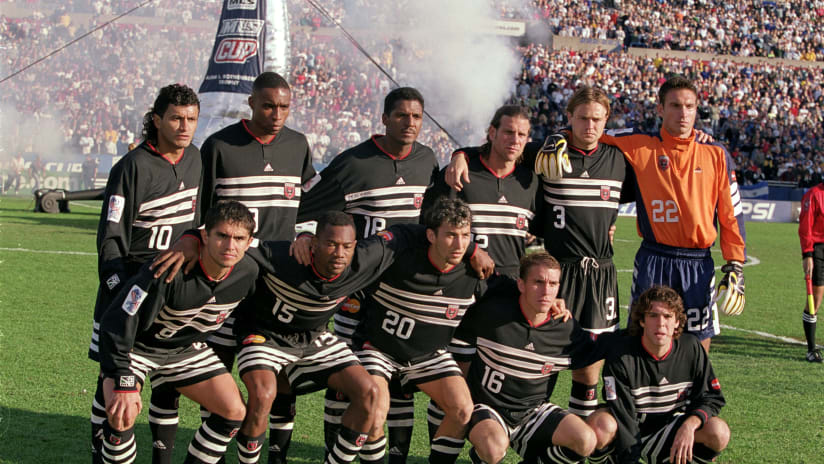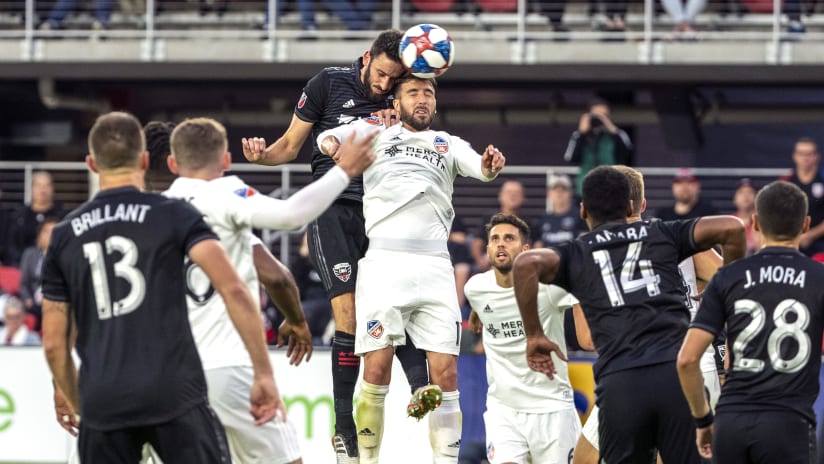More than three weeks have passed since D.C. United midfielder Russell Canouse suffered a partially collapsed lung against the Chicago Fire, leaving the stadium in an ambulance and spending the night in a local hospital. He had collided with attacker C.J. Sapong as both players pursued of a 50-50 ball near midfield, and Canouse was left gasping for air after Sapong’s lower body slammed into his chest.
It was the type of injury Canouse assumed he could walk off, something that might ache for a few minutes and then subside as the adrenaline of live competition kept flowing. But as the inability to catch his breath persisted, Canouse knew it was time to leave the field. And a few hours later — after United and the Fire had drawn, 0-0 — Canouse found himself undergoing minor surgery to address the problem with his lung.
Since then, United have eased Canouse back into training on a limited basis. He participates in individual drills and works on his cardio with members of the medical staff while avoiding scenarios that might put his chest at risk. The entire process tests his patience.
Little by little, though, Canouse is nearing a return with roughly two months of the regular season remaining. He sat for an interview this week to discuss his injury, his recovery and how he stays invested while watching his teammates from the sideline:

(The following was lightly edited for length and clarity.)
Q: Did you have any idea this was going to be something that would keep you out for a month or more when it happened?
A: When it initially happened, it felt like I got the wind knocked out of me. It felt like I was just going to have a bruised rib or something where I could kind of fight through it like I normally try to do. That’s also why I tried to keep playing. I got up two times, when down two times. Eventually I had to sub myself off because of the pain I was in and not getting enough air. But initially, no, I did not expect to be out this long. I felt like maybe it was something smaller. But afterwards I was like, OK, it could be something that internally that we need to check out.
Q: So when you were talking to the doctor after the game and he says, ‘I think it might be best if you go to the hospital,’ were you surprised by that?
A: I was having a hard time breathing after, like when I was sitting on the bench and after the game. But I still was a little hesitant. I normally think I’m a pretty tough guy. I’ve played through things, and you don’t expect something like that to happen. It’s kind of crazy. I guess the chances of that happening are very, very slim. You don’t really believe it when it happens, and that was kind of the case with my situation as well.
Q: Did you go through a lot of tests after you arrived at the hospital?
A: Yeah. When I got there, they checked me out. I went in and did an X-ray. That obviously came back with some worrying results. From there, then I went and got a CT scan just to confirm what we saw in the X-ray, and that’s obviously what — we had a talk with our team doctors that it was best to stay at the hospital overnight and do what I needed to do to get better.
Q: I think you said they had to put something in your chest, right?
A: It was a chest tube to pull the air out. I had that in for a day. When they pulled that out, I actually felt back to normal. I was really sore, obviously, from the tube being in my chest cavity. And I still had a bruised rib. But it’s been a pretty decent process coming back to health. I feel good here after three weeks already. I’m doing a lot on the field like sprinting, touching the ball. I could probably be back in training now but I have to avoid contact. It’s been a little frustrating just because of the patience I’ve had to have.
Q: Did they have to cut your chest to insert the tube?
A: It was a really small incision. It was nothing really big. There’s no scarring, nothing. It’s already gone.
Q: I know you had to take the train back from Chicago. How miserable was that ride?
A: That was frustrating because obviously I couldn’t fly after the surgery. The only way to get back was the train ride. It was 19 hours, which ended up turning into probably 21 hours. No Wi-Fi. It was an experience and part of the process.
Q: How do you try to stay involved and invested when you can’t actually be in the games yourself?
A: I’m watching every game. I’m there in the locker rooms before the game trying to support the guys and make sure they know that I’m there for the team, even though I’m not playing on the day. I’m still there encouraging them to have a good game. I think that’s important. And then obviously staying in the team meetings, making sure I stay in rhythm from a tactics perspective and preparing for these games even though I’m not playing. That’s important for me. I like to stay professional in those aspects so when I get back in training, the return to playing is seamless and pretty easy.
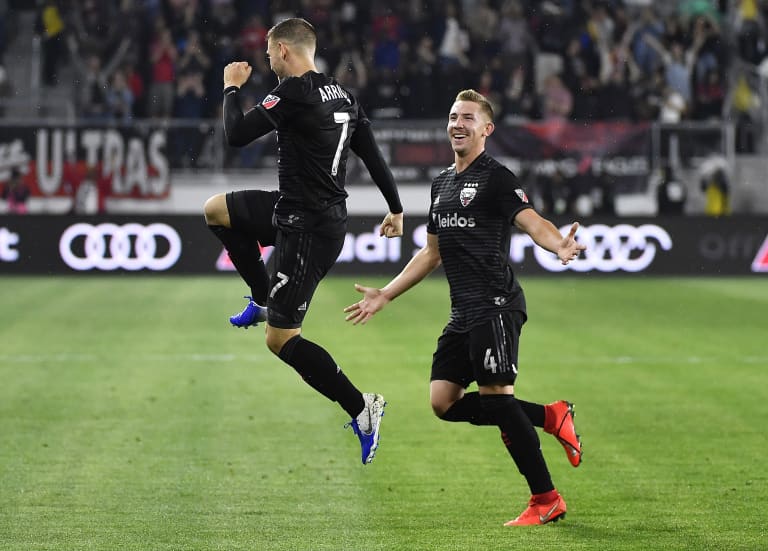
Q: Have you tried to focus more on cardio since you have to avoid contact? Do you find yourself wanting to run more just to stay in shape as much as you can?
A: Yeah, the fitness component is important since I’m not completely training. Obviously I’ve been game fit, I’ve played a lot of games this year, so coming back I won’t need much time. It’s getting back in training and then I should be ready to go for a weekend, whenever that comes. These few weeks here are obviously preparation for that time. A lot of running, a lot of ball work, a lot of individual (drills), change of direction, sprints and stuff to keep my fitness so when I come back in, it’s easy.
Q: Whether you miss a few games for an injury or whether it’s the gap between the end of one season and the start of another, what is it that takes a little bit of time to sharpen once you get back on the field? Is there anything you have to settle in with?
A: I think it’s a little different with this injury compared to an offseason. It’s different just because we’re mid- to end of season and I’ve played a lot of games this year. So it’s not that difficult coming back in and finding your rhythm, especially because I’m already touching the ball and staying in here (with the guys) the last three weeks. Offseason is a little tougher because you’re not in a team environment, you’re not training at a high level all the time and you’re off for about two months. So it depends what injury (you’re talking about), but it’s difficult coming in after the offseason and trying to find your rhythm. That takes a little bit of time.
Q: What have you thought of the team bringing in midfielder Felipe Martins? What will that competition will be like with you, Felipe and Junior Moreno once you get back out there?
A: I think he’s done well. I think we’ve got a good group of center mids, even with Chris Durkin as well when he gets back from his ankle injury. I think we’ll have a good group to handle the middle of the park going into the end of the season and playoffs. I think we all provide different things that the game needs at different times. There are good complements to each of the relationships.
Q: Do you see things differently watching a game from the stands or from a suite while you’re injured?
A: Watching from the stands, you’re more of a spectator. For me, it’s frustrating watching from the stands just because I’m not in there impacting the game. So I’m not a fan of that, obviously. But you get a little bit more of a tactical perspective when you’re watching from the stands, which is good. Sometimes it’s good to see that, sit back and see where the team needs to improve and how you can personally impact the game that way.
Q: When you can get back out there, what do you think is going to be key for this team to enter the playoffs on a high note?
A: I think we just need to continue to have the mentality of going out to grind games and put a full effort in. I think the games that we’ve gotten results the past few months have been in those types of performances, so we need to keep in mind that that’s what we need moving into the playoffs.

